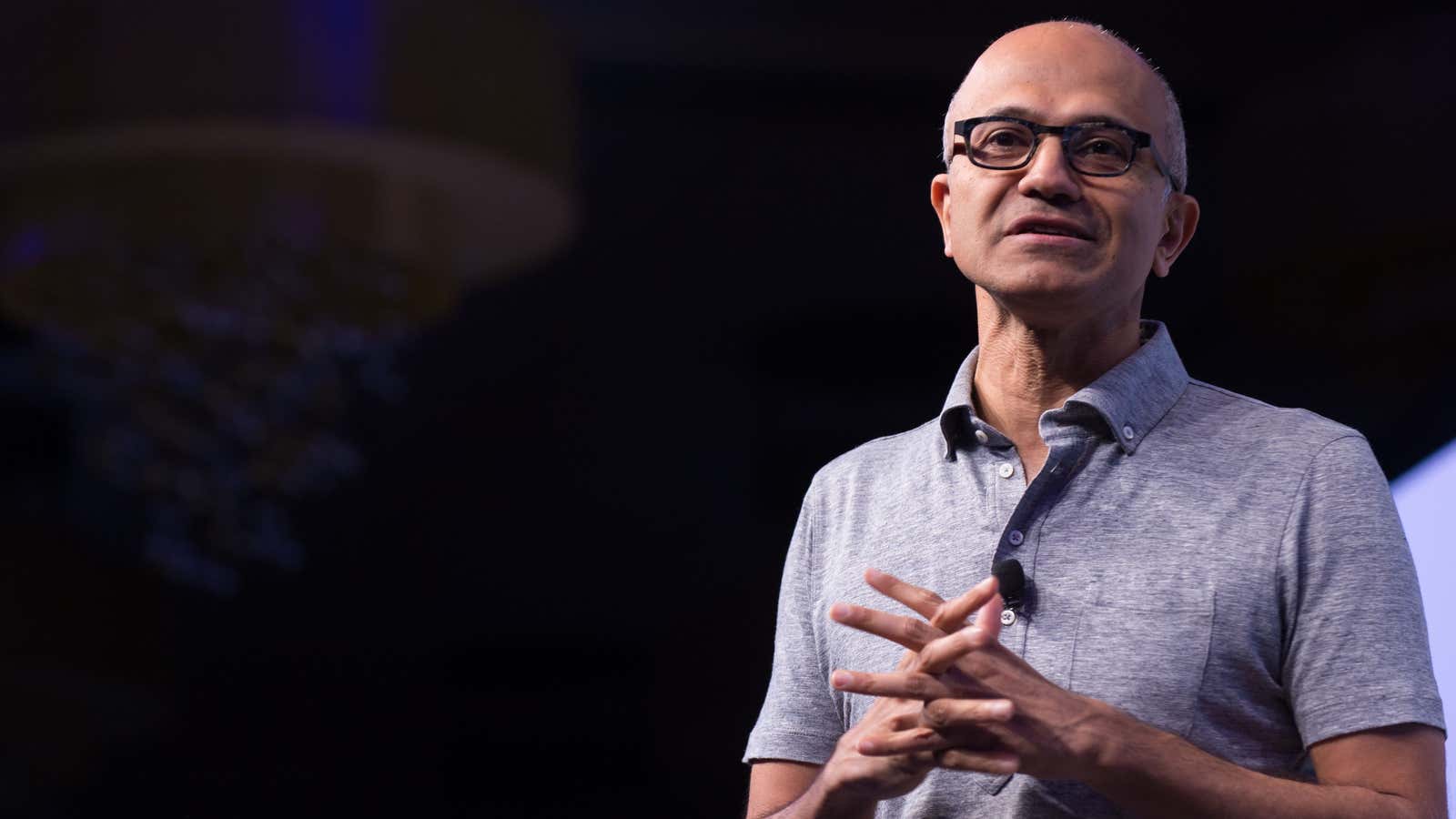It was March 27, 2014, and Satya Nadella was about to make his first public appearance as CEO of Microsoft. The tone, he knew, would be important.
Nadella’s predecessor, Steve Ballmer, was famous for making public appearances feel epic. At a 1991 meeting in Japan, he seemed to injure his vocal chords because he was screaming “Windows” with such force. In 2000, when Microsoft celebrated its 25th anniversary, Ballmer reportedly popped out of a giant cake. And in 2013, when he announced he was stepping down, he bid farewell to 13,000 Microsoft employees as “(I’ve had) The Time of My Life” blared through the speakers of Key Arena in Seattle. Through tears, the 6’5” Ballmer shouted, “Soak it in all of you. You work for the greatest company in the world.”
Nadella was not that kind of CEO.
A 5’11”, cricket-loving engineer from Hyderabad, India, Nadella had built a reputation as a mild-mannered manager who spent his free time taking online classes on neuroscience and reading poetry. The previous month, he had become CEO of the world’s fourth most valuable company, but the Microsoft he inherited was a far cry from the one he had joined in 1992.
For one thing, Microsoft had just paid $7.2 billion to acquire Nokia’s mobile business, a deal Nadella had voted against as a member of the senior leadership team because, as he explains in his autobiography, he “did not get why the world needed the third ecosystem in phones.” The Windows phone had a mere 4% market share, sipping on the dregs left over from Apple and Google.
But on that day in March, Nadella was not thinking about how to integrate Nokia’s 33,000 employees into his team. He was about to make an announcement that would set a precedent for his tenure as CEO.
Microsoft was going to release a version of its signature software suite—Microsoft Office—on the iPad, bucking Microsoft’s reputation for not collaborating with rivals. (As the keynote speaker at Salesforce’s Dreamforce conference two years later, Nadella used an iPhone during a product demo, a sight that would’ve been unimaginable in the Ballmer era.)
For this announcement, though, there was not much pomp and circumstance. The company rented out a small room in a San Francisco event space. It was an intimate setting, filled mostly with journalists and a few Microsoft employees. There Nadella was in the heart of Silicon Valley, in his first public appearance as CEO, about to start a partnership with one of his company’s sworn enemies.
However, on the morning of the event, Nadella and his team were not worried about what he was about to say. They were worried about where he was going to say it.
The room was set up with a two-meter tall stage from which Nadella could speak down to the audience. But Nadella and his team didn’t want to send the message that he was a supreme ruler, bestowing the plebeians with his presence.
Before he spoke, he wanted to shorten the stage.
Shortening the stage has become an apt metaphor for Nadella’s tenure as Microsoft’s chief executive. He has, by and large, shifted the spotlight away from the pulpit and onto the masses. Since taking over as CEO five years ago this February, Microsoft’s share price has tripled. Last November, its market capitalization briefly passed Apple’s, temporarily making Microsoft the most valuable company in the world.
The company has made notable acquisitions of the popular game Minecraft, the developer platform Github, and the social network LinkedIn. And it has successfully repositioned itself—going from a “devices and services” company to a “mobile and cloud” company.
But if you ask Nadella how he reinvented Microsoft in half a decade, he won’t talk about the cloud computing or the billion-dollar acquisitions. For him, changing the direction of a ship carrying 130,000 employees could only be done by changing the culture on board.
Confronting the culture of Microsoft
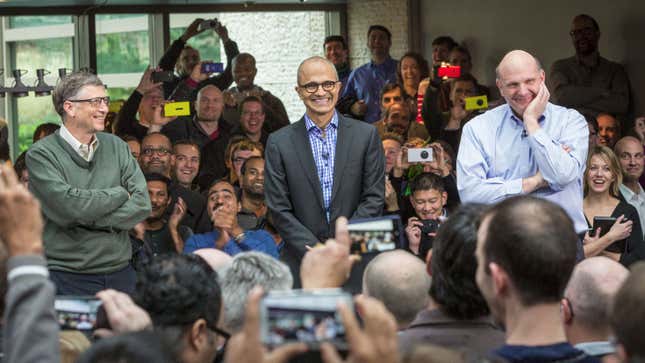
In 2011, Manu Cornet, a designer famous for his satirical cartoons about tech, posted a mock Microsoft org chart on his personal blog that went viral. The chart consisted of different departments all pointing guns at each other. According to the dozen current and former Microsoft employees we spoke to for this article, the satire was glazed in a heavy coat of truth.
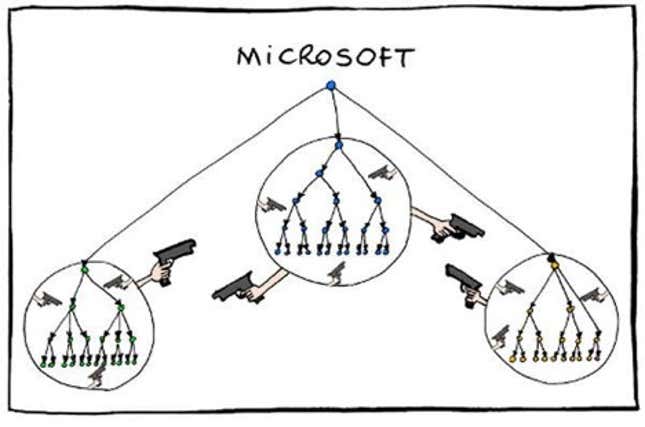
Perhaps no system encapsulated Microsoft’s old culture of competition better than the company’s performance review system. In certain departments, managers were asked to assign a number one through five to each member of their team. According to employees who worked at the company during the Ballmer era, managers were encouraged to assign a certain number of fours and fives (the worst numbers), in a sort of implicit quota system.
“Even if you had an all-star team, you still had to put someone in the five bucket,” an engineering manager who asked not to be named told Quartz. “The number became a permanent scar on [the employee’s] record that would impact things like their ability to change teams.”
Ballmer’s Microsoft was also famous for not playing well with others. In an interview with the Chicago Sun-Times in 2001, Ballmer called Linux, an open-source operating system and popular Windows alternative, ”a cancer that attaches itself in an intellectual property sense to everything it touches.”
The open-source concept, or the idea that software should be shared publicly for others to use, was popular among programmers who believed collaboration was key to technological progress. But Microsoft’s posture seemed to value its own bottom line over the collectivist ethos popular among the web’s early pioneers.
David Golds, an engineer who left Microsoft in 2012 after 14 years with the company, decided to rejoin in 2017 under the new regime. “What changed was leadership, and everything followed from that,” he says. “There was a tearing down of walls for software developers and tearing down of walls in the physical office.”
But before Nadella began redesigning the internal review process or physical campus, his first order of business was to redefine the company’s mission. Microsoft co-founder Bill Gates’ famous mantra of “a computer on every desk” was no longer resonant for a 21st-century enterprise tech company.
Nadella needed to give the company a new north star.
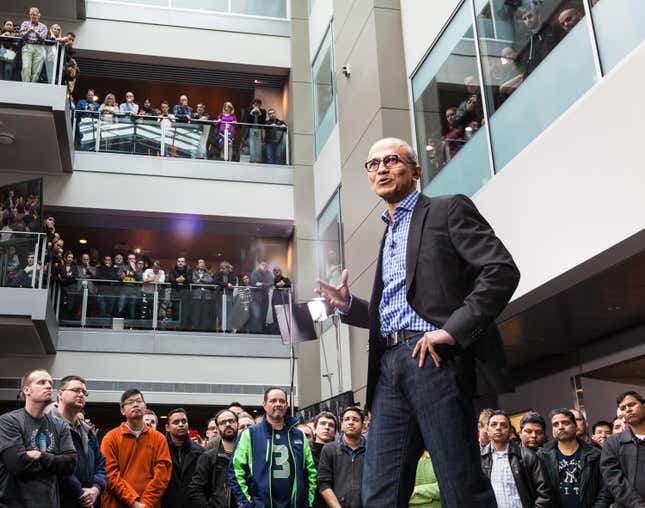
At 6:02 am Pacific time, five and a half months after he took over as CEO, Nadella sent out an email with Microsoft’s new raison d’etre.
Microsoft existed to “empower every person and every organization on the planet to achieve more.” Though vague enough to deserve a place in the pantheon of corporate sweet nothings, the new mission offered a semantic shift that would define Microsoft for the five years that followed: It would become a people company instead of a product company.
Embracing a growth mindset
Apart from Nadella, the person most responsible for Microsoft’s cultural shift might be a Stanford psychology professor named Carol Dweck.
Nadella credits Dweck’s 2007 book Mindset: The New Psychology of Success with defining his philosophy on company culture. Ask any Microsoft employee and they’ll be able to sum up Nadella’s philosophy in two words: growth mindset.
The phrase, an important component of Dweck’s scholarship, suggests that intelligence and talent are not fixed traits and that the true mark of success is one’s ability to learn. At Microsoft, it has become a sort of internal rallying cry. The walls of the company’s Redmond, Washington, headquarters campus are filled with inspirational quotes about “inviting in new ideas” and “fostering curiosity.”
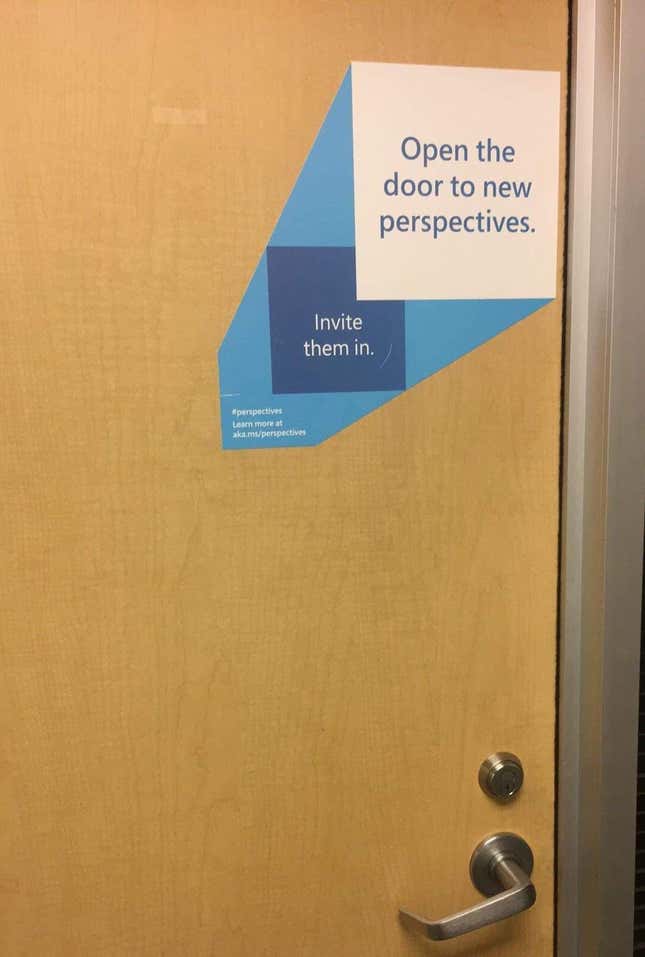
Growth mindset has been revolutionary at Microsoft not because it is a revolutionary idea in and of itself, but because of how profoundly it differs from what Microsoft valued in the past.
In the past, clinging to the idea that, say, Microsoft needed a phone or Microsoft needed an MP3 player led the company to continue investing in products that the market decidedly didn’t want. On the culture side, employees were hesitant to surface new ideas for fear of breaking from the charted course.
Emily Orrson, a marketer on the Minecraft team, remembers a line from the first speech she heard Nadella make. “He said, ‘If you don’t like your job, tell your manager,’ and I remember thinking that I could finally be honest about how I wanted to grow.”
“We went from a culture of know-it-alls to a culture of learn-it-alls,” says Chris Capossela, Microsoft’s chief marketing officer. “Everything we do now is rooted in a growth mindset.”
You see growth mindset reflected in product decisions—like the company’s investment in HoloLens, Microsoft’s augmented-reality glasses that began as a moonshot project with a high risk of failure. You see it reflected in the promotion of continuous learning. (Nadella, for example, sends out video blogs to the company discussing the books that he’s reading.) And you see it reflected in the company’s internal practices, like the company’s new performance-review structure.
But as much as growth mindset is about innovation, it is also about learning from mistakes. In 2014, not long after he took over as CEO, Nadella was interviewed at a conference in Phoenix, Arizona, celebrating women in computing. Harvey Mudd College president Maria Klawe, who is on the Microsoft board, asked Nadella what advice he had for women who didn’t feel comfortable asking for a raise.
“It’s not really about asking for a raise, but knowing and having faith that the system will give you the right raise,” Nadella responded, essentially telling the 7,500 female engineers in attendance to trust a system that systematically pays women 80 cents for every dollar made by their male counterparts.
“I answered that question completely wrong,” Nadella wrote in an internal memo to employees, posted later that day. The misstep showed that even a thoughtful leader like Nadella has his blind spots. The beauty of the growth mindset, though, is that you can let a mistake become a learning opportunity.
However, when it comes to gender diversity, Nadella’s company still has a long way to go. Microsoft is the only one of the big five technology companies to employ less than 30% women. Though the acquisition of LinkedIn helped boost the percentage of women from 25.5% in 2017 to 26.6% in 2018, the overall numbers are little changed from where they were when Nadella took over as CEO.
But Nadella has arguably bought himself some time on the issue, if only by generating goodwill with the other changes he’s brought to Microsoft’s culture.
One Week
Perhaps no change is more indicative of Microsoft’s new values than the annual employee meeting Nadella began convening in 2014. Every August, all of Microsoft’s employees are invited to Washington for a week-long gathering aptly called One Week.
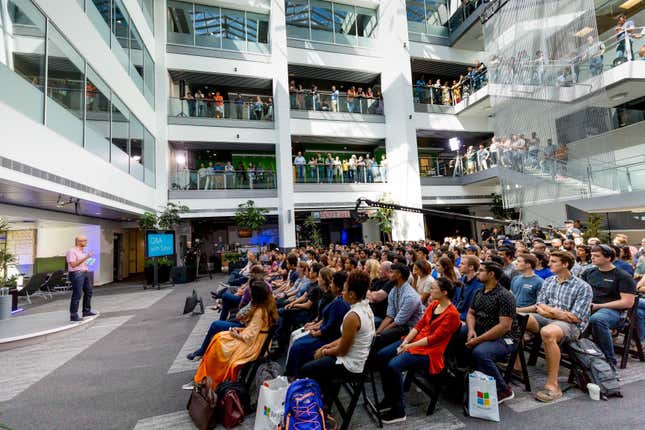
The week is dotted with different company expos, presentations, and Q+A’s with Microsoft’s senior executives, but the highlight is a three-day hackathon where employees are encouraged to work on projects—either in-person or remotely—that fall outside of their day-to-day tasks. In 2017, more than 18,000 people in 4,000 cities and 75 countries participated.
Like a college graduation, giant tents are erected on the company’s Redmond campus. Nadella strolls through the hundreds of project spaces, sampling demos like a tourist at a farmer’s market.
Computer interfaces controlled by eye moment, adaptive controllers for the Xbox, and artificial intelligence for the visually impaired are just three of the many projects conceived at the hackathon that have since been rolled out to the public.
The hackathon is most notable, though, for what it reflects about its host. In many ways, it’s a microcosm of all the ways Microsoft has changed since Nadella has taken over: thousands of employees from across different departments, working together to experiment, learn, and build. No longer is Microsoft an amalgam of warring city-states, competing for resources and recognition. The company has dropped its proverbial guns.
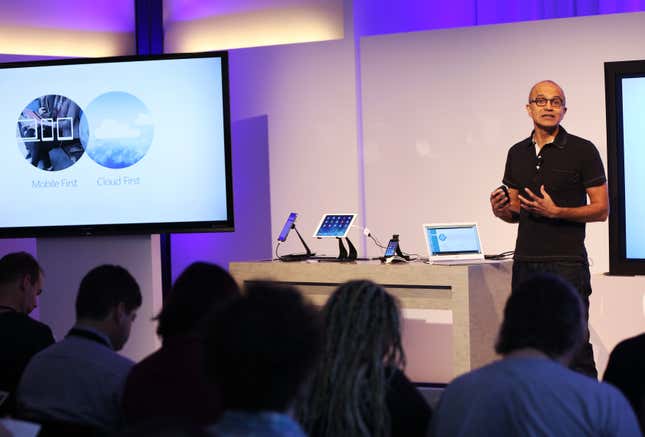
At Nadella’s first appearance as CEO, that Office for iPad event back in 2014, he borrowed from T.S. Eliot to describe his goal for the company’s future: “You should never cease from exploration, and at the end of all exploration, you arrive where you started and know the place for the very first time.”
The quote has aged well. At the time, the board had just concluded a six-month search for a new CEO. Many thought they would look to external candidates—after all, the company was in danger of fading into irrelevance and needed a substantial change to correct course. Ford CEO Alan Mulally, Qualcomm COO (now CEO) Steve Mollenkopf, and Nokia CEO Stephen Elop were largely thought to be frontrunners in the race.
The decision to appoint Nadella, an internal candidate who had already been with the company for more than two decades, came as a surprise to many. He had no CEO experience, was steeped in Microsoft tradition, and was an engineer first and foremost.
But Nadella’s genius was knowing that if Microsoft wanted to change, it had to start from within.
Read pieces from our field guide to Microsoft here:
